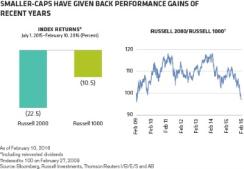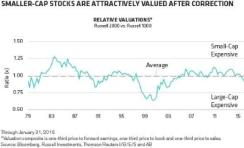Smaller U.S. stocks were hit harder than their large-cap peers during the January sell-off. We think the harsh treatment is unwarranted, and a strong recovery could be in the cards when risk appetite returns.
Sharp downturns in equity markets are never kind to small-cap stocks. Over the past seven months, the Russell 2000 index of smaller-cap stocks has fallen by 22.5 percent, whereas the Russell 1000 index of large-cap stocks fell by only 10.5 percent. The slump wiped out the strong performance gains that small-caps had been enjoying over large-caps since the 2008–’09 financial crisis (see chart 1).

After the correction, valuations look attractive, in our view at AllianceBernstein. When compared with large-caps on several metrics, the relative valuation of small stocks hasn’t been this low since the end of 2003 (see chart 2). But investors are still wary. Smaller names are still considered much riskier.

Do all smaller-cap stocks really deserve such a bad reputation? We don’t think so. Although U.S. small-caps are risk assets that are vulnerable in market drawdowns, if you choose the right companies — with solid fundamentals — they aren’t necessarily as dicey over the long term, as many investors believe.
Recent selling has been indiscriminate. Small stocks fell sharply across a broad range of sectors, even though individual company profiles are very diverse. Within small- and midcap, or SMID, stocks, there is a wide range of companies with different attributes in terms of valuation, free cash flow, quality and growth. The gap between the most attractive and least attractive stocks on measures of value has widened to levels not seen since 2011. Yet by punishing smaller stocks so harshly, investors are treating them as if they’re all equally dangerous.
The anxiety is inconsistent. Although concerns about China, oil prices and global economic growth are real, abandoning all small U.S. companies isn’t necessarily the right response. Small companies can adjust business models much faster than can their larger peers, and thus can position themselves to weather the current environment more effectively. Also, small U.S. companies get a higher share of their revenue from domestic markets than do larger corporations, so they can benefit from the U.S. economy’s relative strength.
When choosing smaller stocks, we don’t think macroeconomic analysis is the key to long-term success. Bottom-up research into the sources of a company’s business advantages and earnings potential should be the focus, even when markets are fixated on economic trends.
That principle is perhaps even more valid today. By focusing on a small slice of the market with much stronger fundamentals, active managers can scoop up stocks with more resilient characteristics and better return potential at attractive valuations.
The trick is to look for companies that have diverse return drivers. In other words, search for companies that are exposed to different types of business trends, ones that aren’t directly driven by economic cycles. Look for companies that are restructuring to improve their cash flows but have not yet been rewarded for their efforts. Or consider companies in the health care sector that are exposed to structural growth trends created by the Patient Protection and Affordable Care Act, which is boosting patient numbers and transforming industry dynamics.
Small-cap stocks often do well after a market meltdown. They outperformed strongly following the 2008–’09 financial crisis, as shown in the above chart. Yet it’s almost impossible to time a potential inflection point. So we believe it’s important to be invested before the market turns. During seven small-cap bull markets since 1926, which lasted 5.2 years on average, the average one-year annualized return was 37.3 percent. Our research shows, however, that if you missed the best month of each bull market, your annualized return would fall to 31.2 percent. And missing the best five months would cut your returns to 16.2 percent a year.
When markets are so shaky, it’s easy to understand how anxiety spreads to smaller stocks. Yet it’s also a great opportunity to find small companies that can pack a big punch in a recovery. At times like the present, we believe investors should consider reallocating to a small-cap or a SMID portfolio, which can offer premium return potential in a broader market recovery.
Bruce Aronow is chief investment officer, U.S. small/SMID-cap growth; James MacGregor is CIO, small- and midcap value equities; Samantha Lau is co-CIO, U.S. small/SMID-cap growth; and Shri Singhvi is director of research, small- and midcap value equities; all at AB in New York.
See AB’s disclaimer.
Get more on equities.






